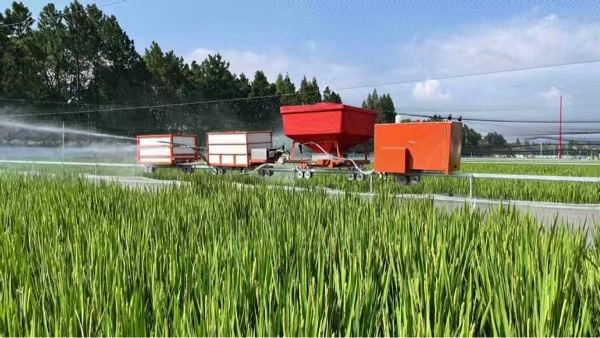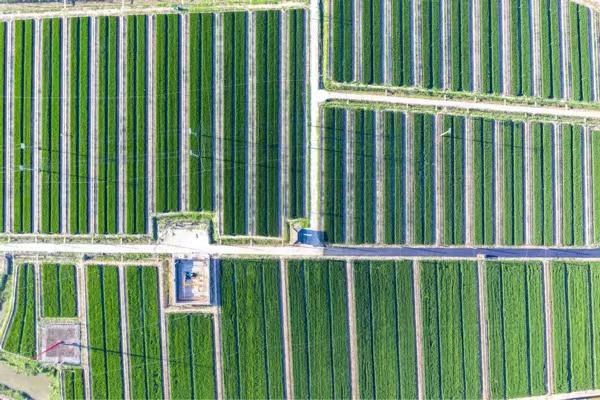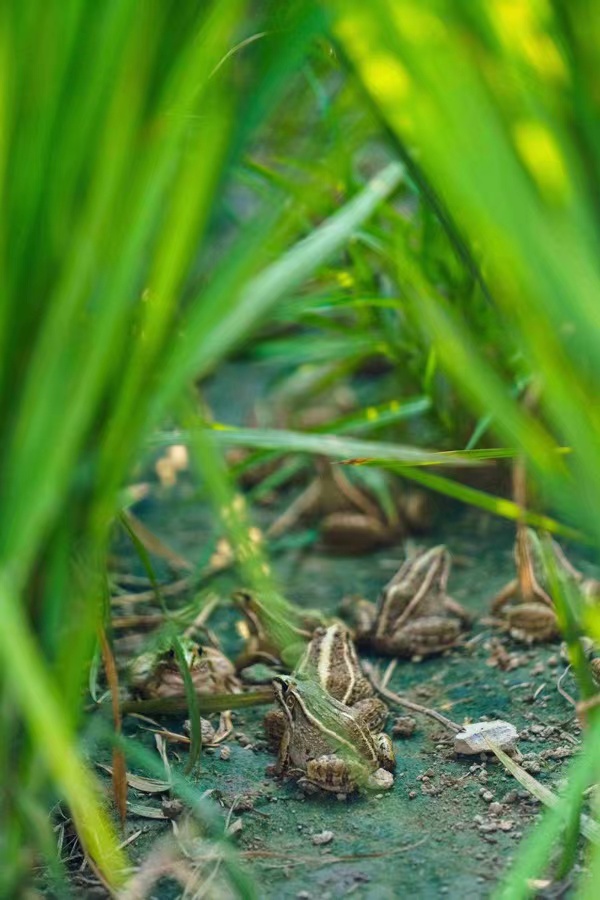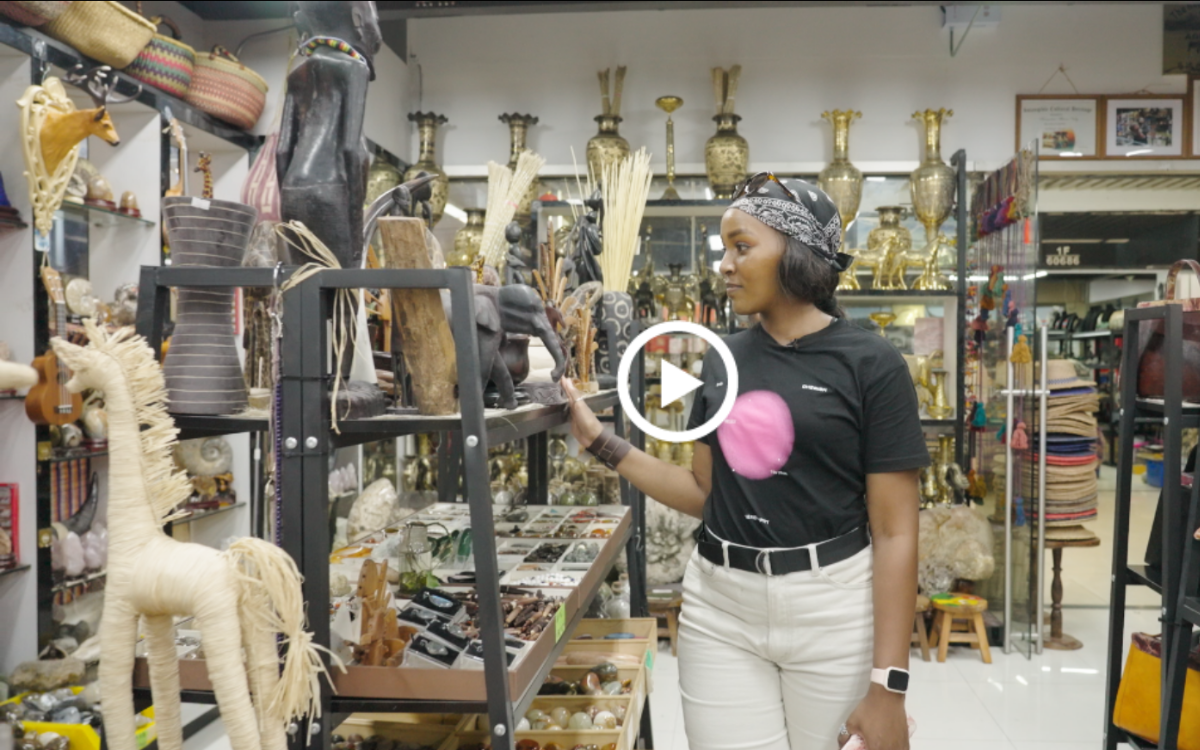Frog-rice project helps village jump ahead

Fields dedicated to the sustainable, combined cultivation model for rice and black-spotted frogs in Changxing county, Huzhou, Zhejiang province, are watered by a mechanized sprinkler irrigation system. CHINA DAILY
A combined cultivation model is creating symbiotic success in the countryside. Ma Zhenhuan reports from Hangzhou.
A highly efficient and sustainable model of the combined cultivation of rice and black-spotted frogs has achieved financial and environmental success in recent years in Chengshan, a village in Changxing county, Huzhou, in the eastern province of Zhejiang.
"This symbiotic model had been functioning for a long time before it bore fruit," said Wu Chuanyi, a frog expert who was the first person in the province to receive a license to breed them.
"In 2010, no one had any professional, practical experience in the artificial breeding of black-spotted frogs in China. But out of love and interest, I conducted a small-scale trial," Wu said, adding that he created a special feed for the frogs consisting of fly maggots, earthworms and yellow mealworms.
Wu said that his original intention was to prevent the frogs from becoming extinct.
"As the market demand for black-spotted frogs was large, I considered breeding them artificially so the wild frog population could be protected and market demand could be met at the same time," he said.
Wu said his model also contributes to the development of the ecological environment, a concept promoted by President Xi Jinping that emphasizes the sustainable coexistence of humanity and the environment.
"Black-spotted frogs are very different from other kinds of frogs," he said. "They are ferocious, with amazing ability to jump. They can catch insects within 1 meter of the rice fields, which fully meets their growth and reproductive needs."

A bird's-eye view of the combined cultivation area for rice and black-spotted frogs in Changxing. CHINA DAILY
Wu is also general manager of Zhejiang Changxing Daohuaxiang Agricultural Technology. Located in Chengshan, the company mainly focuses on agricultural scientific research and sales of edible agricultural products.
The company was established in 2013 and began breeding the frogs on 5.3 hectares of land the following year, Wu said, explaining the development of the business.
In 2015, the breeding area was expanded to 13.3 hectares, and the following year, the company began to develop its combined cultivation model.
By 2020, the model had caught on with some local farmers, who used it to raise their incomes, thus promoting China's goals of rural vitalization and common prosperity, Wu said.
The project has attracted a great deal of attention from both local villagers and the government.
"Last year, the collective economic cooperatives of Chengshan, Heping town, participated in the project. With the help of my company's technology, 27.8 hectares of local peach forests were used to plant rice and raise frogs, solving the unemployment problem of low-income seniors in the village," Wu said. He added that the value of the company's output reached 9.75 million yuan ($1.38 million) last year, making a net profit of 4.43 million yuan.
Li Qicai, a member of the Communist Party of China's branch in Chengshan, said the village "warmly welcomed this project".
"More than 27 hectares of fertile land used for the combined cultivation of rice and black-spotted frogs have been rented out by villagers, who each earn an average annual rent of about 800 yuan per mu ($1,706 per hectare)," Li said.
"The project has helped more than 30 elderly villagers find work in their hometown, and has helped more than a dozen poor families who were each given free shares to earn dividends."
As of this year, more than 200 hectares of land have been used for the combined cultivation project in other places in Huzhou and in other cities such as Hangzhou and Jiaxing, which has raised incomes and provided jobs for more than 400 rural households.

Black-spotted frogs are ferocious and are expert jumpers. They can catch insects within 1 meter of the fields that have been sowed with rice under the novel cultivation model. CHINA DAILY
Ru Jianliang, vice-chairman of the association for science and technology in Changxing, said the combined cultivation of rice and black-spotted frogs is symbiotic: the fields serve as feeding grounds for the frogs, who eat pests. In turn, the frogs' feces helps fertilize the fields so the rice can grow.
"The model aims to curb the use of chemical fertilizers and pesticides. It reduces the cost of pest control by 110 yuan per mu ($235 per hectare) and the cost of chemical fertilizer by 80 yuan per mu ($171 per hectare)," Ru said.
Ru added that the yield of both the frogs and the rice can amount to more than 7,500 kilograms per hectare, and that the revenue per hectare can reach about 159,000 yuan "which is much higher than that of conventional rice planting".
Wu said: "To meet the challenges of the fast-growing market, science and technology, the company has made more of an investment in the research and development of digital production and management systems, as well as in the deep processing of agricultural products. We are now fully prepared for the further development of modern ecological agriculture."
Fang Xiaoying contributed to this story.





 play
play